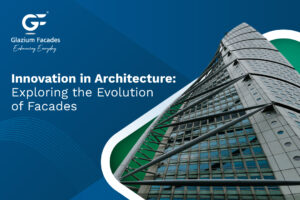

Table of Contents
Innovation in Architecture: Exploring the Evolution of Facades
The role of facades in architecture is crucial, as they shape both the aesthetics and functionality of a building. Facades not only enhance the exterior appearance of a structure but also play a vital role in improving its performance. They create a unique identity for a building through innovative design and usability.
As we move towards a sustainable future, it is essential to design facades that meet the criteria of energy efficiency. Facade engineering plays a significant role in achieving this goal, shifting the focus from conventional designs to cutting-edge innovations. The evolution of facades is directly linked to the evolution of architecture.
Significance of Facades in Architecture
The facade of a building is like its public face, representing its character and purpose to the outside world. However, facades are not just about aesthetics. They play a crucial role in ensuring energy efficiency, environmental sustainability, and occupant comfort. In modern architecture, there is a growing emphasis on the need for intelligent facade solutions that balance form and function.
Facade engineering has emerged as a specialized field that focuses on the integration of materials and technologies to enhance a building’s performance. This includes the use of advanced materials, such as high-performance glass and innovative shading systems, to reduce energy consumption and improve indoor comfort. Additionally, it involves the integration of building systems, such as lighting and ventilation, to create a cohesive and efficient building envelope.
The benefits of a well-designed facade are numerous. A high-performance facade can significantly reduce a building’s energy consumption, resulting in lower operating costs and a smaller carbon footprint. It can also improve indoor air quality and thermal comfort, creating a healthier and more productive environment for occupants. In short, facade is a critical component of modern building design, enabling architects and engineers to create buildings that are both beautiful and sustainable.
Evolution of Facades: Transforming the New-Age Architecture
Facades have come a long way from their traditional designs to the current era of smart and adaptive components. In the past, they were primarily static, serving as a protective layer against the weather elements. However, with the advancements in materials such as glass, metal, and composite materials, facades have undergone a significant transformation. Today, they are not only aesthetically pleasing but also energy-efficient and sustainable.
As we look to the future of architecture, it is clear that the facade will continue to be a focal point of innovation. The integration of smart technologies, sustainable materials, and a commitment to functional aesthetics will shape the buildings of tomorrow. Architects, engineers, and facade companies are working together to redefine the possibilities, creating a built environment that not only meets the needs of the present but anticipates the future.
Glazium, a prominent facade company in India, has been at the forefront of this evolution, incorporating state-of-the-art technologies and sustainable practices in its designs. Their innovative approach to facade engineering has resulted in the creation of smart facades that can adapt to changing weather conditions, regulate indoor temperature, and reduce energy consumption. With Glazium Facade expertise, buildings can now have facades that are not only functional but also visually appealing and environmentally friendly.
Shift from Traditional to Modern Facades
Facades have undergone a significant transformation, shifting from traditional materials to innovative solutions that prioritize sustainability, efficiency, and aesthetics. Conventional facades, typically made of brick or concrete, have been replaced by lightweight and versatile materials, such as aluminum, which have revolutionized the field.
Aluminum facades are one of the most sought structural components in modern times due to their wide range of applications. They are known for their durability, lightweight nature, and versatility, offering architects and designers a wide range of possibilities. Glazium Facades, with its expertise in working with aluminum, has pushed the boundaries of creativity, delivering projects that seamlessly blend form and function.
Applications of Facades in Modern Architecture
Glass and aluminum facades, known for their versatility, have been utilized in residential projects, retail spaces, and institutional buildings across the world. The adaptability of modern facade engineering allows architects to seamlessly integrate these solutions into diverse design schemes.
In commercial buildings, facades contribute to overall sustainability by regulating temperature, maximizing natural light, and reducing reliance on artificial lighting and heating systems. In residential projects, facades are designed for privacy, aesthetics, and energy efficiency, creating a harmonious living environment.
Facades are not limited to skyscrapers and commercial structures; they have various applications in different architectural contexts.
Energy Efficiency:
- Thermal Regulation: Modern facades often incorporate advanced materials and designs to regulate the building’s temperature, reducing the need for excessive heating or cooling. This helps in energy conservation and sustainability.
- Solar Control: Facades may include elements like sunshades, louvers, or high-performance glazing to control the amount of sunlight entering the building, minimizing heat gain and optimizing natural lighting.
Sustainability:
- Green Facades: Some modern buildings integrate green facades or living walls, which consist of plants or other vegetation. These not only contribute to aesthetics but also improve air quality, provide insulation, and promote sustainability.
- Renewable Energy Integration: Facades can be designed to incorporate renewable energy technologies such as solar panels or photovoltaic systems, contributing to the building’s energy needs.
- Smart Facades: Integration of smart technologies in facades allows for dynamic adjustments based on environmental conditions. This may include automated shading systems, responsive lighting, and dynamic glass that adapt to changing light and temperature conditions.
Aesthetics and Innovation:
- Architectural Expression: Facades are a crucial element of architectural expression. Modern architects use innovative materials, textures, and forms to create visually striking facades that contribute to the identity of a building.
- Parametric Design: Parametric design tools enable architects to create complex and unique facade designs, allowing for a high degree of customization and variation in patterns, shapes, and textures.
- High-Performance Materials: Advances in material science have led to the development of high-performance facade materials with improved insulation, durability, and aesthetic qualities. This includes materials like aluminum facades, glass-reinforced concrete, and advanced metal alloys.
- Optimizing Natural Light: Modern facades are designed to maximize natural light penetration into the interior spaces. This not only enhances the visual comfort of occupants but also reduces the reliance on artificial lighting during the day.
In the wake of environmental consciousness, the architectural industry is increasingly embracing sustainable practices. Facade companies, including Glazium Facade, are incorporating eco-friendly materials and energy-efficient designs to create environmentally responsible buildings. The integration of sustainable facade solutions not only reduces the ecological footprint but also enhances the overall performance of the structure.
Conclusion:
The way buildings are designed and constructed has changed due to the evolution of facades in architecture. Innovative materials and engineering techniques have played a significant role in this transformation. Glazium Facades is contributing to this change by introducing sustainable practices and creative solutions. The future of facades promises to be even more exciting, with a focus on combining aesthetics, functionality, and environmental responsibility.
The art of Facade manufacturing is a combination of engineering and architecture. As technology advances, we can expect more advanced and sustainable structures. Glazium Facades is an example of excellence in facade design and development for delivering cutting-edge structural solutions. Their team of experts works carefully to craft stunning facades to transform your buildings into spectacular architecture. The next time you admire a modern building exterior, remember the hard work and dedication that went into creating it.

Behind the Scenes: The Art of Facade Manufacturing Jan 24

Innovation in Architecture: Exploring the Evolution of Facades Jan




Hi, Neat post. There’s an issue together with your web site in internet explorer, may test this�IE still is the marketplace chief and a good component of people will pass over your fantastic writing due to this problem.
I have been surfing online more than 4 hours today, yet I
never found any interesting article like yours. It is pretty
worth enough for me. In my view, if all web owners and bloggers made good content as you did, the internet
will be a lot more useful than ever before.
tadalafil o cialis tadalafil maxon cena cialis forum discussion
tadalafil 10mg price cialis testimonials forum tadalafil genericon
typical cialis prescription cialis vs vardenafil tadalafil cialis generika
Насколько надежна многофакторная аутентификация
двухфакторная аутентификация rdp впн кз .
tadalafil generico 5mg cialis generico chile kde koupit tadalafil
canadian made tadalafil cialis tadalafil citrate tadalafil goodrx
buy tadalafil australia tadalafil maxon chpl is cialis vegan
teva viagra pricing amazon prime sildenafil sildenafil brand names
viagra substitute gnc sildenafil citrate liquid viagra actress
sildenafil en vademecum viagra masculino viagra gel boots
cialis non daily cialis generic drug cialis daily benefits
otc cialis tadalafil auf kassenrezept prescription for cialis
bilder von viagra viagra prescription label viagra pregnancy category
cialis drugstore heallthllines tadalafil emc pil tadalafil kopen
viagra company name viagra bijsluiter sildenafil citrate images
Hi Neat post Theres an issue together with your web site in internet explorer may test this IE still is the marketplace chief and a good component of people will pass over your fantastic writing due to this problem
cialis france pharmacie cialis generic version tadalafil pah dosage
sildenafil piller sildenafil citrate contraindicaciones aarp viagra price
tadalafil ou cialis tadalafil tablets 5mg cialis dosage cialiscz2022
viagra prescription alternatives viagra chat sildenafil chewy
tadalafil cialisbanksy tadalafil drug study pde5 inhibitors tadalafil
tadalafil 20mg tablets tadalafil reviews effectiveness tadalafil or cialis
standard dose viagra viagra mg 50 viagra manufacturer
tadalafil maker generic tadalafil reviews cialis coupons walgreens
viagra generic wikipedia viagra other words sildenafil vs losartan
cialis cialisbanksy com cialis 5mg directions cialis medications
mexico viagra prices viagra script sildenafil citrate density
sildenafil for female sildenafil pills 100mg sildenafil tablet strength
levitra dozlar levitra best levitra 20mg kohl
sildenafil brand name rx viagra coupon viagra samples walgreens
vardenafil levitra 20mg crestor and levitra levitra generico foro
gabapentin and sildenafil viagra jet lag lady viagra price
viagra 200mg dose sildenafil tablet online sildenafil control substance
sildenafil citrate meaning buy viagra boots sildenafil mylan køb
levitra starting dose levitra spray levitra studies
viagra renal dosing watermelon lemon viagra viagra honey packet
joz sildenafil 100mg bnf sildenafil dose histoire du viagra
levitra alternative uses vardenafil pregnancy category levitra prezzo bayer
taking viagra results who makes viagra viagra hangover
nina turner viagra viagra questionnaire pdf viagra sildenafilo
levitra cardiac levitra antibiotikum levitra death
viagra with dapoxetine viagra supplement facts sildenafil citrate 50mg
viagra fast acting risks of viagra best viagra alternatives
levitra dosing instructions vardenafil tablet online vardenafil levitra 10mg
sildenafil 100mg cena viagra hims viagra dose strength
sildenafil citrate brands nebenwirkungen sildenafil citrate viagra bestellen veilig
tadalafil natural substitute tadalafil 5mg hindi cialis posologie prix
levitra enalapril achat levitra paris levitra pakiranje
cialis uk prescription tadalafil cipla reviews maxim peptides tadalafil
viagra vademecum sildenafil citrate schedule viagra zamienniki
viagra mexico precio viagra precio similares viagra demonstration
levitra headache remedy cialis levitra wirkung levitra wroclaw
women taking cialis cialis otc sanofi tadalafil side dosage